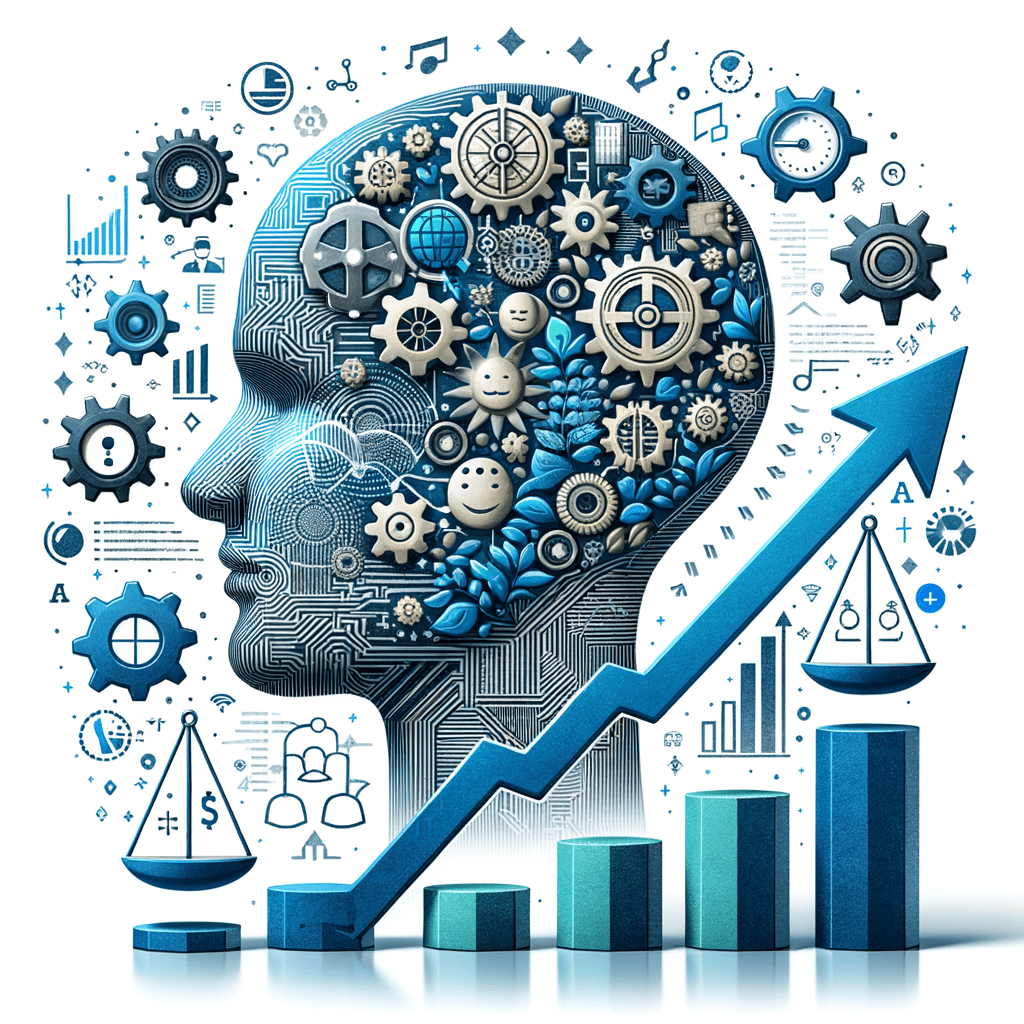In today’s fast-paced business world, companies constantly seek ways to boost efficiency and productivity. Using AI to measure employee productivity is gaining traction. This technology offers possibilities for organizations looking to optimize their workforce and drive business growth.
The Rise of AI in Workplace Productivity
Using machines to enhance human capabilities dates back to the 1960s. Computer scientist J.C.R. Licklider envisioned a future of “cooperative interaction between men and electronic computers”. Today, AI has become integral to many workplace processes. These range from automating routine tasks to providing insights into complex data sets. AI provides precision and objectivity in measuring employee productivity that traditional methods often lack.
The Power of Data-Driven Insights
A key advantage of using AI to measure employee productivity is its ability to process vast amounts of data. AI systems can analyze everything from keystrokes and mouse movements to email response times. AI analyzes project completion rates and provides actionable insights.
This data allows managers to understand how their teams perform. They can access real-time, data-driven insights. This replaces reliance on subjective assessments or sporadic performance reviews.
Personalized Performance Tracking
AI tailors its analysis to individual roles, departments, and projects. This personalization enables accurate and relevant productivity assessments. This considers the nuances of different jobs and their unique contributions.
For example, AI might measure a customer service representative’s productivity with various factors. It considers customer satisfaction scores and problem resolution rates in addition to the number of calls handled.
The Benefits of Using AI to Measure Employee Productivity
Let’s explore the concrete benefits AI can bring to organizations and productivity measurement.
Improved Efficiency and Time Management
AI tools identify time-wasting activities and inefficient processes. The average knowledge worker spends a significant amount of time on tasks like gathering information. AI can streamline this, freeing time for more productive work. This increased output benefits both the employee and the company.
Enhanced Decision Making
AI-powered productivity insights inform management decisions. This improves decisions about resource allocation, training needs, and performance strategies. This data-driven approach leads to more effective team management and overall results. It supports productivity gains and improves the employee experience.
Increased Employee Engagement
Using AI to measure employee productivity can actually boost engagement. When employees have clear objectives and productivity metrics, they are often more motivated. Oxford University research shows happier workers were more productive.
Identifying High Performers and Growth Opportunities
AI helps identify top performers and potential leaders. It also pinpoints areas where employees may benefit from additional training. This enables targeted professional development initiatives, optimizing training programs for better results. It helps hr leaders focus on talent management and career growth for employees.
Potential Challenges and Ethical Considerations
It’s important to acknowledge the potential challenges and ethical considerations of using AI to measure employee productivity. Responsible implementation is crucial.
Privacy Concerns
Using AI for productivity measurement raises questions about employee privacy. There’s a concerning trend in using surveillance software to track activities. Organizations must be transparent about the data collected and its usage. This is important to maintain trust and ensure employee rights are protected.
Bias and Fairness
AI systems can reflect biases present in the data they are trained on. This poses a risk of perpetuating or creating new biases in performance evaluation. Organizations must ensure fairness in their AI systems. They must ensure data privacy and avoid discrimination. Regular performance reviews help address potential biases and refine algorithms. This contributes to creating a fairer workplace and improves employee satisfaction.
Overemphasis on Quantitative Metrics
AI excels at measuring quantitative data, but it may struggle to capture qualitative aspects. Creativity, teamwork, and emotional intelligence are also vital for success. Avoiding an overemphasis on easily measurable metrics is essential. Organizations should strive for balance in productivity measure and avoid neglecting these important factors.
Best Practices for Using AI to Measure Employee Productivity
Organizations should follow these best practices to maximize benefits and minimize risks:
| Practice | Description |
|---|---|
| Prioritize Transparency | Be open with employees about the data collected, its use, and its purpose. This transparency builds trust and addresses privacy concerns. It fosters a positive employee experience and demonstrates respect for individual rights. |
| Combine AI Insights with Human Judgment | AI should inform decisions, not replace human judgment. Managers should interpret AI insights and make final decisions. This balanced approach prevents over-reliance on machine learning and maintains a human-centered workplace. |
| Regularly Review and Adjust AI Systems | Regularly audit AI systems for bias and effectiveness. Be willing to adjust or replace systems if needed to ensure fairness and accuracy. Continuous improvement helps optimize productivity measure while upholding ethical standards. |
| Focus on Employee Development | Frame AI-driven measurement as a tool for employee growth. Use insights to provide constructive performance feedback and targeted support. This fosters a culture of continuous learning and improvement. It ensures productivity effects align with development goals and enhance overall employee experience. |
| Respect Employee Privacy | Implement data protection measures. Give employees control over their data. Avoid intrusive monitoring that can damage morale. Respecting privacy demonstrates ethical data handling and safeguards employee rights. This fosters a positive work environment. |
The Future of AI in Productivity Measurement
As AI evolves, expect more sophisticated approaches to measuring employee productivity. AI will increasingly play a crucial role in optimizing productivity ai. This is especially true for optimizing employee productivity ai for maximum efficiency and benefit to companies.
Some potential future developments include:
- Advanced natural language processing to analyze written communication. This provides data for understanding team dynamics and optimizing team performance.
- Integration with wearable technology to measure physical indicators of productivity and well-being.
- AI-powered virtual assistants to provide real-time productivity tips and suggestions. This empowers personnel to identify areas for personal productivity enhancement. It gives them the tools and knowledge for effective time management.
Staying informed and adapting practices is crucial as these technologies emerge.
FAQs about Using AI to measure employee productivity
How can AI measure employee productivity?
AI measures employee productivity by analyzing data like time spent on tasks and project completion rates. It also examines communication patterns, web searches within the company network, and even keystrokes. Advanced AI considers qualitative metrics like customer satisfaction. AI processes this data to provide insights into individual and team performance. This analysis identifies trends and areas for improvement, leading to more informed talent management and optimized business goals. Productivity gains become tangible with the use of quantitative data analysis powered by artificial intelligence.
How do you measure the productivity of an employee?
Measuring employee productivity involves combining quantitative and qualitative metrics. Quantitative measures include output, sales figures, or completion rates. Qualitative measures include peer reviews, customer feedback, or work quality assessments. AI assists by collecting and analyzing these data points. This provides a comprehensive view of an employee’s productivity. It contributes to more data-driven decisions about resource allocation, talent management, and performance feedback. Regular performance sessions become even more effective with detailed data that identifies areas needing support. Personnel files are no longer the sole basis of understanding employee contribution. Productivity gains become quantifiable, providing solid ground for strategic planning and informed resource allocation.
How does AI affect employee productivity?
AI significantly impacts productivity in multiple ways. AI automates routine tasks, freeing up time for more complex work. AI tools give real-time feedback and suggest improvements, creating a positive feedback loop for employees. AI analyzes work patterns to identify inefficiencies and suggest optimizations. Employees might experience a learning curve when adapting to new AI systems.
How does AI help in productivity?
AI boosts productivity by automating tasks, giving data-driven insights, and offering personalized recommendations. AI streamlines workflows, predicts bottlenecks, and even assists in creative processes. AI improves resource allocation and workload management, maximizing efficiency and overall output. This empowers employees to focus on tasks requiring creativity and problem-solving. AI-powered tools help people work more efficiently, achieving productivity gains across different roles. Performing tasks becomes smoother, leading to better management outcomes, greater job satisfaction, and higher productivity measure.
Conclusion
Using AI to measure employee productivity transforms workforce management. AI provides objective performance insights. This helps businesses identify improvement areas, recognize top performers, and create engaging environments.
It’s important to address privacy concerns, potential biases, and over-reliance on quantitative metrics. Ethical and thoughtful AI implementation enhances productivity, employee satisfaction, and overall business performance.
The future of work is here, powered by intelligent machines working with human ingenuity. Artificial intelligence empowers better management of business goals by streamlining performance management processes. Measuring productivity becomes easier and helps customer support agents as well as customer service departments better meet customer demands. Increased output and client success are within reach with better understanding of current ai systems. Understanding the current ai helps leaders harness its strengths to drive overall productivity increased and provide actionable recommendations. The ability to analyze data collected allows companies to refine workflows and ensure data privacy remains protected. Addressing concerns ai by mitigating the risks ensures responsible implementation of productivity ai across the workplace and aligns productivity ai tools with overall productivity metrics and talent management practices.






